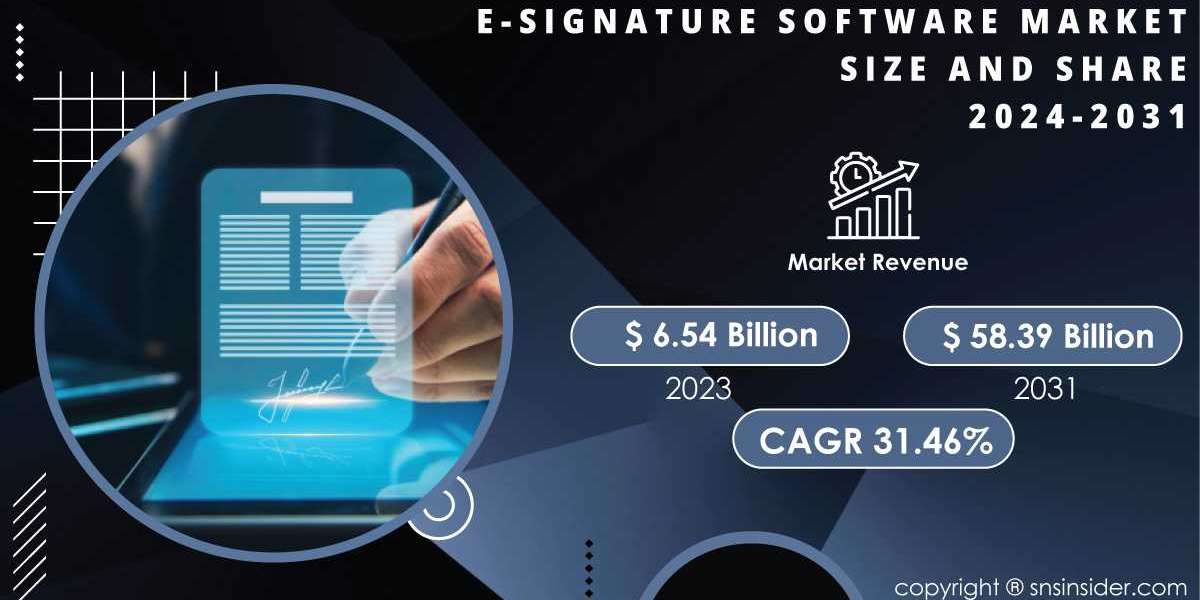E-Signature Software 2024
E-signature software has become an essential tool for businesses worldwide, revolutionizing how documents are signed and managed. Traditionally, the signing process involved printing, signing by hand, and then scanning or mailing documents. This cumbersome method is increasingly being replaced by digital solutions that offer greater efficiency, security, and convenience. E-signature software enables users to electronically sign documents, streamlining workflows and enhancing productivity across various industries.
E-Signature Software Market Size was valued at USD 6.54 Bn in 2023 and is expected to reach USD 58.39 Bn by 2031 and grow at a CAGR of 31.46% over the forecast period 2024-2031.
The Mechanics of E-Signature Software
E-signature software facilitates the signing of electronic documents through secure, digital means. These platforms use various technologies to ensure the authenticity and integrity of the signed documents. The core components of e-signature software typically include authentication mechanisms, electronic signature capture, document management, and compliance features.
Authentication mechanisms are crucial for verifying the identity of the signers. This can involve methods such as two-factor authentication, biometric verification, or secure login credentials. Once authenticated, users can electronically sign documents using various methods, including typing their name, drawing a signature, or using a stylus.
Document management features within e-signature software ensure that signed documents are stored securely and can be easily accessed when needed. These features include document tracking, audit trails, and version control. Compliance with legal and regulatory requirements is another critical aspect, with many e-signature solutions adhering to standards such as the Electronic Signatures in Global and National Commerce (ESIGN) Act and the European Union's eIDAS regulation.
Benefits of E-Signature Software
The adoption of e-signature software offers numerous benefits for businesses and individuals alike. One of the primary advantages is increased efficiency. Traditional paper-based signing processes can be time-consuming, involving multiple steps and delays. E-signature software accelerates the signing process, enabling documents to be signed and returned in a matter of minutes.
Cost savings are another significant benefit. Reducing the need for physical paperwork, postage, and storage can result in substantial cost reductions. Additionally, the automation of document workflows reduces the administrative burden, allowing employees to focus on more strategic tasks.
E-signature software also enhances security and compliance. Electronic signatures are often more secure than traditional ink signatures, as they include encryption and authentication measures to prevent tampering and fraud. Compliance with legal and industry standards ensures that e-signatures are legally binding and recognized in various jurisdictions.
Moreover, e-signature software contributes to environmental sustainability by reducing the need for paper and ink. This aligns with the growing emphasis on eco-friendly practices and corporate social responsibility.
Market Trends and Innovations
The e-signature software market is characterized by rapid innovation and evolving trends. One notable trend is the integration of artificial intelligence (AI) and machine learning. AI-powered features, such as automated signature verification and document analysis, enhance the accuracy and efficiency of e-signature processes. Machine learning algorithms can also predict and identify potential fraud or anomalies, further strengthening the security of electronic signatures.
Another significant trend is the increasing adoption of cloud-based e-signature solutions. Cloud technology offers scalability, flexibility, and cost-effectiveness, making it an attractive option for businesses of all sizes. Cloud-based platforms enable seamless integration with other digital tools and applications, providing a more comprehensive and streamlined approach to document management.
Mobile accessibility is also on the rise, with many e-signature solutions offering dedicated mobile apps or responsive designs. This allows users to sign documents from their smartphones or tablets, providing greater convenience and flexibility.
The growing emphasis on regulatory compliance is driving innovation in e-signature software. Providers are continuously updating their platforms to adhere to new and evolving legal standards, ensuring that their solutions remain compliant with global and regional regulations.
Challenges and Considerations
Despite its advantages, e-signature software also faces several challenges. One of the primary concerns is ensuring the security and privacy of sensitive information. Businesses must implement robust security measures, such as encryption and multi-factor authentication, to protect against potential threats.
Integration with existing systems and workflows can also be a challenge. Businesses often use various software solutions for document management, customer relationship management (CRM), and other functions. Ensuring that e-signature software integrates seamlessly with these systems is crucial for maximizing its benefits.
User adoption and training are other considerations. While e-signature software offers significant benefits, employees and clients must be familiar with its features and capabilities. Providing adequate training and support is essential for successful implementation and utilization.
The Future of E-Signature Software
The future of e-signature software is promising, with continued growth and innovation expected. Advances in technology, such as blockchain and biometric authentication, are likely to further enhance the security and functionality of e-signature solutions.
Blockchain technology offers a decentralized and immutable ledger for recording and verifying transactions. By leveraging blockchain, e-signature software can provide an additional layer of security and transparency, reducing the risk of fraud and tampering.
Biometric authentication, including fingerprint and facial recognition, is another area of development. These technologies offer a more secure and user-friendly method of verifying identities, further strengthening the integrity of electronic signatures.
As businesses continue to embrace digital transformation, the adoption of e-signature software is expected to grow. The increasing demand for efficient, secure, and eco-friendly solutions will drive innovation and expand the market for e-signature software.
In conclusion, e-signature software has transformed the way documents are signed and managed, offering significant benefits in terms of efficiency, cost savings, security, and sustainability. As technology continues to evolve, e-signature solutions will play an increasingly central role in the digital landscape, shaping the future of business transactions and document management.
Contact Us:
Akash Anand – Head of Business Development Strategy
info@snsinsider.com
Phone: +1-415-230-0044 (US) | +91-7798602273 (IND)
About Us
SNS Insider is one of the leading market research and consulting agencies that dominates the market research industry globally. Our company's aim is to give clients the knowledge they require in order to function in changing circumstances. In order to give you current, accurate market data, consumer insights, and opinions so that you can make decisions with confidence, we employ a variety of techniques, including surveys, video talks, and focus groups around the world.
Read Our Other Reports:
IT Asset Disposition (ITAD) Market Report














